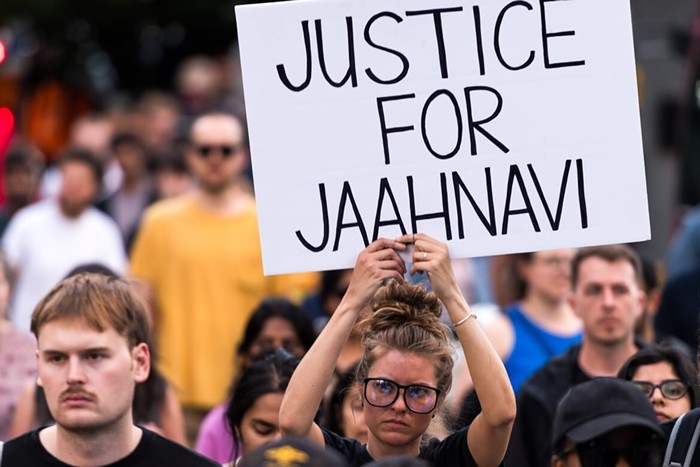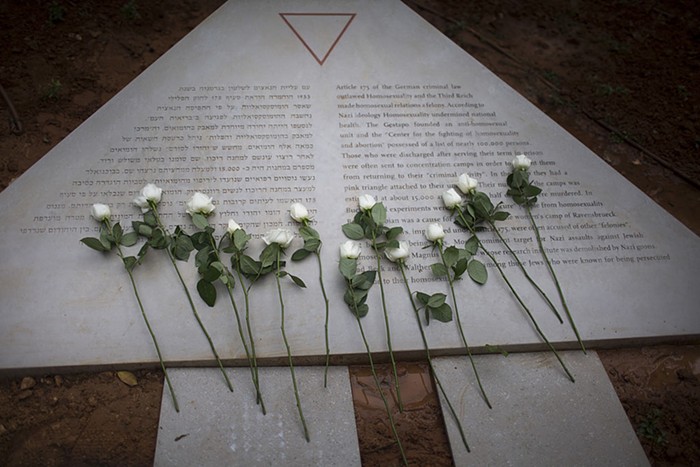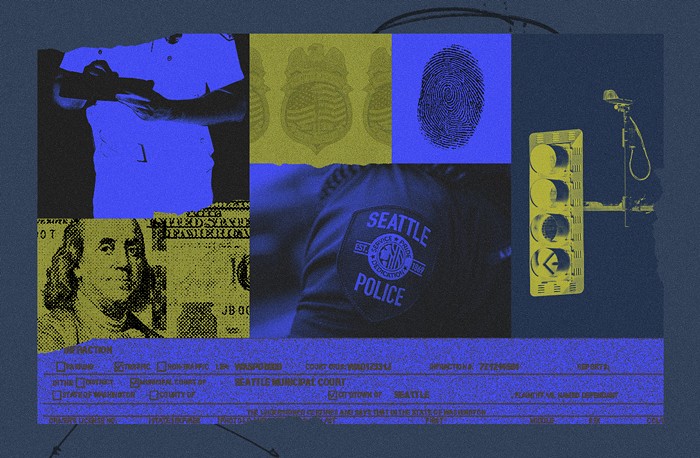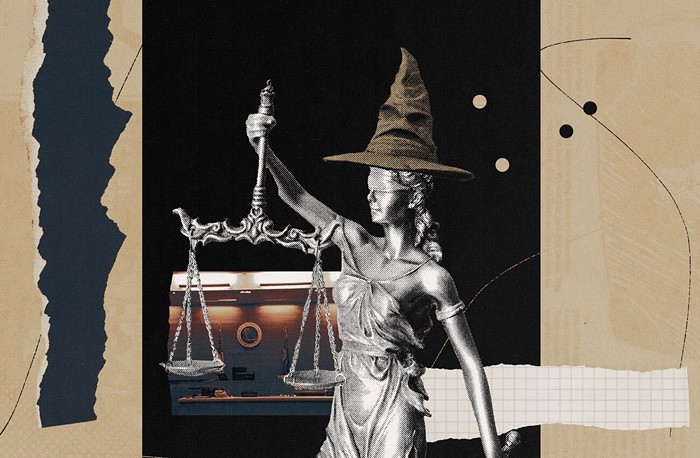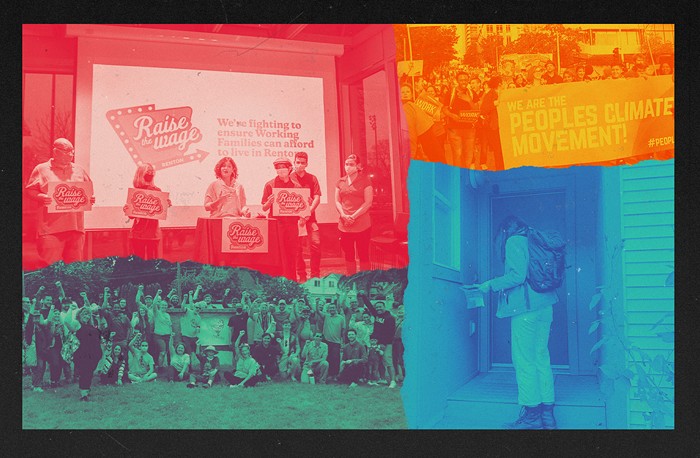Rhiannon Rasaretnam, 17, power-walked up 2nd Ave with her Sierra Club backpack, clutching prepared remarks for a speech she would give to the political group Indivisible. It was 11:30 AM, when most other high school students were in school, but she only had to attend one period for the day. Lucky. This was crunch time.
When Rasaretnam reached the federal building, she looked around breathlessly for her Seattle co-organizer, 17-year-old Emilia Allard.
"Where were you?!" Rasaretnam demanded when her friend arrived.
"There's no parking in Seattle!" Allard said.
Rasaretnam and Allard met just one month ago, when they unknowingly created redundant Facebook pages in the wake of the Parkland school shooting attempting to organize student activists. Rasaretnam, a Tahoma High School student, then reached out to Allard, of Ballard High School, and they decided to work together.
They didn't tell their parents at first. "At that point, we didn't think it was going to be anything big," Rasaretnam said. But within a day, the Facebook group hit a thousand RSVPs. Since then, the group has grown to 8,200, not to mention the addition of an estimated 450 volunteers and a $16,715 GoFundMe. Now the teens organize through a group calendar and various teams (social, logistics, voter registration, fundraising) on the messaging app GroupMe.
On Tuesday, a day the students agreed to let me shadow them, Rasaretnam said she was running on one hour of sleep. She had stayed up late on the March for Our Lives Facebook messenger chat with core student organizers. Both she and Allard are constantly working through their phones. “Sometimes I’ll leave my phone for just an hour to go to class and I come back, and there are like 30 emails,” Allard said.
That day, Rasaretnam and Allard would speak with Seattle Weekly, KUOW, and KIRO 7. Rasaretnam and Allard were offered a chance to meet with Senator Patty Murray staffers, too, but they turned them down. They already met with the senator earlier this month. They had enough on their plates: preparing for today’s student walkout, a town hall with Congresswoman Pramila Jayapal on Saturday, and important decisions within the group about how to incorporate well-meaning elected officials into their work.
This set-up is a deliberate strategy from the students, one that’s informed by the students’ understanding of how national traumas work. Born after Columbine, these students have been raised in an era of mass shootings tumbled through the 24-hour news cycle. They realize the limited attention spans of the adults around them, and from experience, they know what will happen if they sit this one out. To change the conversation, they know they must be the ones to drive it. The students are keenly aware of the unique and historic space they appear to be occupying. “Everyone is always like, ‘take a step back, focus on school,’” Allard told me. “But I don’t think they understand that we can’t take a step back. We’ve been given this opportunity, obviously not just us here in Seattle, but every student who’s a part of these marches. And we’re only going to have this opportunity for so long, when people care and continue to listen.” “We’ve seen that with Sandy Hook as well,” Allard continued. “I think that now is the time we have to capitalize on this and create change.” Sandy Hook is one of the reasons Allard is organizing today. She says she remembers exactly where she was when she got the news that a gunman shot dead 20 elementary school students and six teachers in their classrooms. Allard herself was 12 at the time, but today she thinks about the risks faced by her younger siblings, one of whom is autistic. Allard said she worried how her sister might react in a school shooting like that—her inability to calm herself down in order to hide and save her life. Moments like those, the students said, have defined them. So have other activist movements. Both Rasaretnam and Allard are ardent supporters of the Black Lives Matter movement, whose rhetoric has inspired them to frame their own gun reform activism as a form of “student lives matter.” Rasaretnam, the daughter of a Vietnamese refugee and a Sri Lankan immigrant, has also been working to make her school more inclusive through a group called Activists for Change, as well as at the state level, through Washington’s Legislative Youth Advisory Board. And contrary to the image of Gen Z as social media obsessed, when I ask Rasaretnam and Allard where they get their information, both girls rattle off a list of legacy news sources: CNN, the Washington Post, the Economist, the Wall Street Journal. Allard loves books: Ta-Nehisi Coates’ Between the World and Me, for one. Rasaretnam is directly applying her public school education to her activism, too. Next month, she’ll be attending a national debate-style competition with her school's We the People team, an event she’s been training for over the last several months. She also dealt with universal background checks as a topic on the speech and debate team last November, something that’s come in handy when formulating policy demands to officials. But Rasaretnam and Allard are wary of too much adult interference in this particular moment. “It’s less about them now, and more about us,” Allard said. “I think you have to take into account that everyone has an agenda,” she added. “I mean, we have an agenda.” Part of that agenda is to expand the grown ups’ attention spans beyond Parkland, to other gun-related issues, they said. “All of the sudden we have all of these elected officials supporting the March for Our Lives movement,” Rasaretnam said. “Whereas they stay away from giving outright support for movements like the Black Lives Matter group, because it’s more controversial, because it deals with race, or stuff they don’t want to get into. That’s something I would like to use our platform to address those issues. Because now that they’re paying attention to us, I’d like to help redirect some of that attention to issues that are not fully addressed and should be.” To show me how many adults have taken interest in their work, Allard reached into her backpack and pulled out a mountain of business cards. She'd been meaning to put them into an Excel spreadsheet, but hadn't found the time. But like any organizers, Allard and Rasaretnam were also struggling with how to engage with politicians—or how much space to let them occupy at the March 24 rally. “I was saying, just [give] adults limited time, to keep it youth-centered,” Rasaretnam said. “These are, like, names,” Allard protested. “These people are the ones who can actually create not the lasting impact without us, but with us, through policy change.” But this debate was postponed. Allard had to run to the KUOW interview. Rasaretnam was late for a public speaking advisory meeting at the Columbia City Library, where she would discuss with other students and a couple of adults how to articulate their ideas in a panel setting. As Rasaretnam walked me back to where she parked her dad's pickup truck, I realized it had been a very long time since I had been the passenger in a car driven by a teenager. Rasaretnam, perhaps sensing my discomfort, tried to reassure me. "Don't worry," she said. "I'm a good driver." The rest of the country will have to get used to it. The students are in the drivers’ seats.


